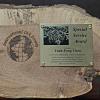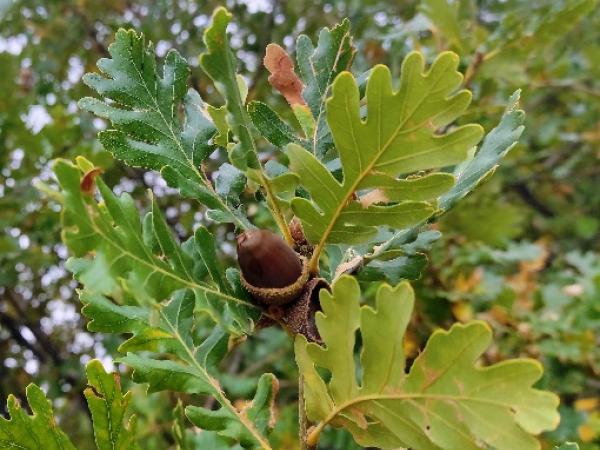Editor's Picks
Plant Focus
To create an account click here; if you have already registered, click here to become a member.
Individual articles can be purchased for U$S 10. If you would like to purchase an article, email a request to website@internationaloaksociety.org
Mark V. Coggeshall, Ryan Russell, and Amy Byrne
Published May 2023 in International Oaks No. 34: 140–148
Abstract
Quercus acerifolia (maple-leaf oak), listed as Endangered on the IUCN Red List, is distributed across four known isolated populations in west-central Arkansas. Our project, initiated in 2021, focuses on the ex-situ conservation of this species, and contributes to the existing Q. acerifolia metacollection. Our approach is unique as we have planted grafted trees across four spatially separated city parks in Columbia, Missouri, with each clonal population representing one of the four in-situ populations of the species. We believe this approach will facilitate future restoration efforts for Q. acerifolia by serving as a source of acorns derived from each of these clonal – but isolated – populations, to produce seedlings for targeted restoration efforts across the four in-situ populations in Arkansas. To address inbreeding concerns, a new seed orchard is planned in collaboration with the USDA Forest Service by re-propagating genotypes from each of the four different populations which should maximize outcrossing between clonal representatives across all populations. To date, we have produced clonal replicates of 40 Q. acerifolia individuals (10 per population), which were successfully outplanted in fall 2022.
Keywords
Quercus, Lithocarpus, Castanopsis, endangered species, buttresses
References
Alexander, L., and K. Woeste. 2017. Pollen gene flow, male reproductive success, and genetic correlations among offspring in a northern red oak (Quercus rubra L.) seed orchard. PLoS ONE 12(2): e0171598. http://doi:10.1371/journal.pone.0171598
Backs, J.R., and M.V. Ashley. 2021. Quercus Conservation Genetics and Genomics: Past, Present, and Future. Forests 12: 882. https://doi.org/10.3390/f12070882
Beckman, E., B. Baker, M. Lobdell, A. Meyer, and M. Westwood. 2019. Quercus acerifolia (E.J. Palmer) Stoynoff & Hess. In Conservation Gap Analysis of Native U.S. Oaks, edited by E. Beckman, A. Meyer, G. Man, D. Pivorunas, A. Denvir, D. Gill, K. Shaw, and M. Westwood. Lisle, Illinois: The Morton Arboretum. https://mortonarb.org/app/uploads/ 2021/08/species-profile- quercus-acerifolia.pdf
BGCI. 2021. State of the World’s Trees. Richmond, UK: BGCI.
Coggeshall, M.V. 1993. Oak tree improvement in Indiana. Annals of Forest Science 50 (Suppl. 1): 416s-419s. https://doi.org/10.1051/forest:19930748
Coggeshall, M.V., and W.F. Beineke. 1986. The use of multiple breeding populations to improve northern red oak (Quercus rubra L.) in Indiana. In IUFRO Conference. A Joint Meeting of Working Parties on Breeding Theory, Progeny Testing and Seed Orchards, edited by Weir, R. 13-17 October, 1986. Williamsburg, VA. pp. 540-546. NC State University Tree Improvement Cooperative.
Erickson, V., C. Aubry, P. Berrang, T. Blush, A. Bower, B. Crane, T. DeSpain, et al. 2012. Genetic Resource Management and Climate Change: Genetic Options for Adapting National Forests to Climate Change. Washington, DC: USDA Forest Service, Forest Management.
Griffith, M.P, E. Beckman, T. Callicrate, J. Clark, T. Clase, S. Deans, M. Dosmann, et al. 2019. Toward the Metacollection: Safeguarding plant diversity and coordinating conservation collections. San Marino, CA: Botanic Gardens Conservation International, USA.
Haavik, L.J., J.S Jones, L.D. Galligan, J.M. Guldin, and F.M. Stephen. 2012. Oak decline and red oak borer outbreak: impact in upland oak-hickory forests of Arkansas, USA. Forestry: An International Journal of Forest Research 85(3): 341-352. https://doi. org/10.1093 /forestry/cps032.
Hoban, S. 2019. New guidance for ex situ gene conservation: Sampling realistic population systems and accounting for collection attrition. Biological Conservation 235: 199-208. https://doi.org/10.1016/j.biocon.2019.04.013.
Hoban, S., T. Callicrate, J. Clark, S. Deans, M. Dosmann, J. Fant, O. Gailing, et al. 2020. Taxonomic similarity does not predict necessary sample size for ex situ conservation: a comparison among five genera. Proc. R. Soc. B 287(1926): 20200102. http:// dx.doi.org /10.1098/rspb.2020.0102.
Humphrey, B.E. 2019. The Bench Grafter’s Handbook. Boca Raton, FL: CRC Press, Taylor and Francis Group Imprint.
Jerome, D., E. Beckman, L. Kenny, K. Wenzell, C. Kua, and M. Westwood. 2017. The Red List of US Oaks. Lisle, IL: The Morton Arboretum. https://mortonarb.org/app/uploads /2021/05/ RedListOaks2020.pdf.
Rosenberger, R., E. Schumacher, S. Hoban, and A. Brown. 2021. Proportional sampling strategy often captures more genetic diversity when population sizes vary. Biological Conservation 261: 109261. https://doi.org/10.1016/j.biocon.2021.109261.
Rosenberger, K., E. Schumacher, A. Brown, and S. Hoban. 2022. Species-tailored sampling guidelines remain an efficient method to conserve genetic diversity ex situ: A study on threatened oaks. Biological Conservation 275: 109755. https://doi.org/10.1016/j. biocon. 2022.109755.
Spence, E.S., J.B. Fant, O. Gailing, M.P. Griffith, K. Havens, A.L. Hipp, P. Kadav, et al. 2021. Comparing Genetic Diversity in Three Threatened Oaks. Forests 12(5): 561. https://doi.org/ 10.3390/f12050561.
Subedi, S.C., B. Ruston, J.A. Hogan, and M.V. Coggeshall. Forthcoming. Defining the extent of suitable habitat for the endangered Maple-leaf oak (Quercus acerifolia). Frontiers of Biogeography.
Zumwalde, B.A., B. Fredlock, E. Beckman Bruns, C. Duckett, R.A. McCauley, E.S. Spence, and S. Hoban. 2022. Assessing ex situ genetic and ecogeographic conservation in a threatened but widespread oak after range-wide collecting effort. Evolutionary Applications 15:1002-1017. https://doi.org/10.1111/eva.13391.















